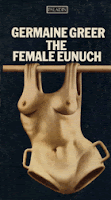
Talk about synergy. On the way to my authors group last night, I picked up a copy of Leo Braudy’s From Chivalry to Terrorism: War and the Changing Nature of Masculinity. Then I learned that on October 2, feminist superstar Susan Faludi is coming out with a new book called The Terror Dream: Fear and Fantasy in Post-9/11 America. Anyone remember how, following 9/11, media headlines declared women to be suddenly less inclined to be satisfied as single and independent beings? And that another baby boom was apparently bound to occur as women’s biological clocks began to tick faster after the tragedy? With what sounds like her hallmark in-depth documentation, Faludi looks at the gendering of cultural response.
The Liberaloc and USA Today have posted excerpts, and here’s what I’ve gleaned (from the book description):
Why, Faldui asks, did our culture respond to an assault against American global dominance with a frenzied summons to restore “traditional†manhood, marriage, and maternity? Why did we react as if the hijackers had targeted not a commercial and military edifice but the family home and nursery?
Faludi shows how an attack fueled by hatred of Western emancipation led us to a regressive fixation on Doris Day womanhood and John Wayne masculinity, with trembling “security moms,†swaggering presidential gunslingers, and the “rescue†of a female soldier cast as a “helpless little girl� The answer, Faludi finds, lies in a historical anomaly unique to the American experience: the nation that in recent memory has been least vulnerable to domestic attack was forged in traumatizing assaults by nonwhite “barbarians†on town and village. That humiliation lies concealed under a myth of cowboy bluster and feminine frailty, which is reanimated whenever threat and shame looms.
In taking on the subject of American culture in the wake of 9/11, Faludi joins fellow superstar Naomi Wolf, who just came out with The End of America: Letter to a Young Patriot, as I mentioned in a previous post. It seems highly relevant that prominent feminist thinkers are turning their attention to the state of our union–which, according to both, is dangerously unraveling. The threat, they both argue, is not merely external; in the wake of 9/11, the threat to our nation’s integrity also comes from within.
I can’t wait to get my hands on these two books. More on this to come, for sure.








